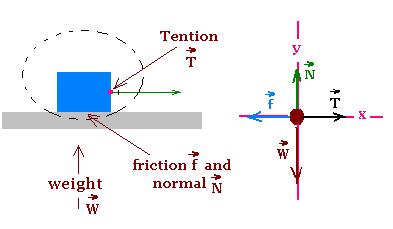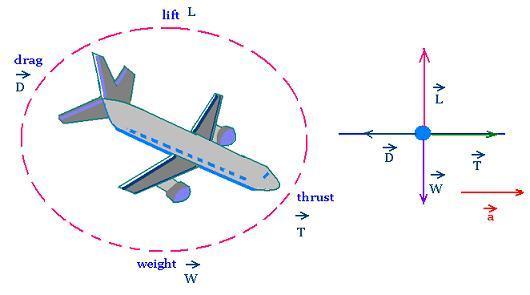Statics
Contents
Applications
© The scientific sentence. 2010
| Statics Free body diagram
1. Free body diagram FBD<
In solving problems in Mechanics, mainly in Statics,
the important step is to draw the free body diagram FBD.
The free body diagram is a material point or a particle that
represents an object of interest to study. It is located
in the origin of a coordinate system. It uses the
particle model.
2. Drawing free-body diagram, the steps
- Draw a picture of the situation, that is the motion diagram,
- Isolate the system (the object) of interest by drawing a closed curve around,
- Identify all forces acting on the object,
- Draw a coordinate system (x, y, z) axis,
- Represent the object as a dot at the origin
of the coordinate axes,
- Draw vectors representing each of the identified forces,
- Label correctly each force vector,
- Draw and label the net force Fnet vector
beside the diagram,
- Point the net force in the same direction as
the acceleration vector on the motion diagram if the object moves,
- Use Newton's laws for each material point.
3. Example 1: A suspended object

An object is suspended by a string. The tension T of the
string is balanced by the weight of the
object W. The object is at equilibrium, therefore
T - W = 0 or T = W
4. How to identify the forces?
The situation contains the system and its environment.
The system is the object of interest whose we want to
study its motion. The environment is everything else around it.
Once a picture of the situation is drawn and the
system is isolated by a curve,
-
Show every contact point with its environment on
the boundary of the curve; such as springs, strings, ropes,
and surfaces. The contact points are the points where
exterior forces pass through,
-
Name and label each contact force acting on the object,
such as tension, friction, or normal,
-
Name and label each at-a-distance force acting on the object,
such as gravitational force.
5. Example 2: block pulled on a surface with friction

The steps:
1 - Define the system: The block,
2 - Draw a picture of the situation,
3 - Draw a closed curve around the system,
4 - Locate the points with the environment:
The rope and the ground ,
5 - Name and label the contact forces:
tension T, normal N and friction ƒ
6 - Name and label the at-a-distance forces:
the weight W.
7. Use Newton's laws:
Over y:
N - W = may = 0
Over x:
F - ƒ = m ax = m a
6. Example 3: Moving aircraft

There are four four forces acting on the airplane:
1 - Weight
2 - Drag
3 - Thrust
4 - Lift
1. Weight:
Weight is the force directed toward the center of the earth.
The magnitude of the weight depends on the mass and the magnitude of
gravity at a certain altitude.
2. Drag:
While the aircraft moves through the air,
the latter resists the motion of the aircraft and the resistance
force is called drag. Drag force is directed along and opposed
to the flight direction.
3. Thrust:
Airplanes use a propulsion to move. The propulsion system generates a
force called thrust. The direction of the thrust force is the one of
displacement.
4. Lift:
Like the drag force, Lift force is an aerodynamic force. It is
generated by the motion of the airplane through the fluid air. It is
directed perpendicular to the flight direction.
Lift force opposes the weight and holds the airplane in the air.
This mechanical force is due to the difference in velocities between
the fluid (air) and the object(spacecraft).
Newton's second law gives:
Over y:
L - W = may = 0
Over x:
T - D = m ax = m a
|
|